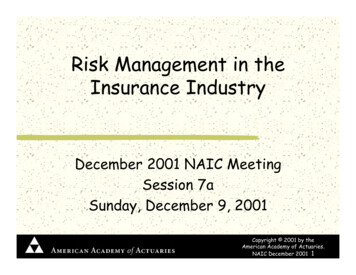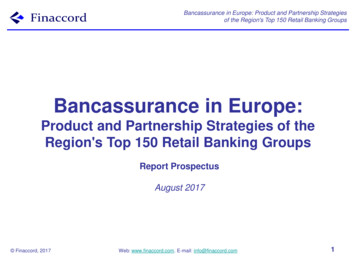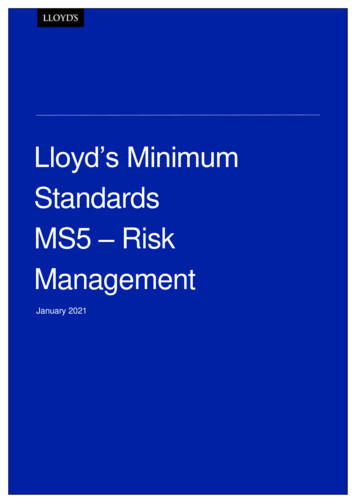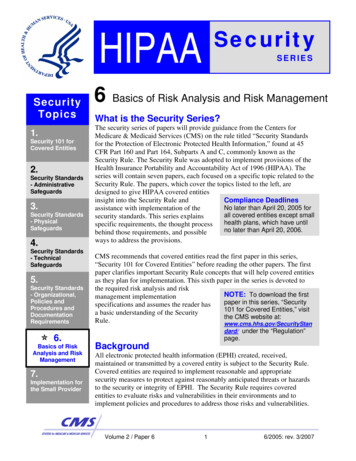
Transcription
Risk Management in theInsurance IndustryDecember 2001 NAIC MeetingSession 7aSunday, December 9, 2001Copyright 2001 by theAmerican Academy of Actuaries.NAIC December 2001 1
PanelistsModerator:Andrea M. Sweeny, FCAS, MAAACasualty Actuarial Assistance LLCPresenters:P & C – Jerry Miccolis, FCAS, MAAATillinghast – Towers PerrinHealth – Donna Novak, ASA, MAAAMMCLife – Dave Sandberg, FSA, MAAAAllianz Life
Overview Outline some framework for assessinginsurance company risk in an organized way Provide some concrete examples/models forrisk management for:-specific risks-use in day to day company decision making-integrated insurance company risk
Overview (continued) Look at risk management structures in thelight of the 9/11 and subsequent terroristevents Outline some of the stresses/impedimentsin designing a good risk managementprocess Summarize some recent insurance industryfindings Highlight area of research and sources formore information
We Hope You Will Take Away A sense of the structure of an insurancecompany risk management process An understanding of the importance of anintegrated program An indication of the volume and kinds ofresearch being done and of how to tap thework that has been completed to date
Risk Management Practicesin the Property/CasualtyIndustryJerry Miccolis, FCAS, MAAATillinghast – Towers PerrinCopyright 2001 by theAmerican Academy of Actuaries.NAIC December 2001 6
What We’ll Cover Some thought-provoking case studies–––Company #1: Risk management as businessmodelCompany #2: A new Chief Risk Officer’s agendaCompany #3: Enterprise Risk Management -- aunifying framework ERM -- the Casualty Actuarial Society view Closing thoughts -- risk management in thewake of September 11
Company #1: Risk Management AsBusiness Model Property catastrophe reinsurer The objective is to optimally leverage capital The focus is on underwriting risk–Includes asset risk and insurance risk–Does not include strategic risk, operational risk The model–Start with world-class natural catastrophe modeling andeconomic scenario generation modeling–Simulate overall “probability of profit” distribution for theenterprise
Company #1: Risk Management AsBusiness Model The model (cont’d)–Determine risk tolerance -- and therefore requiredcapital–Evaluate each deal based on its impact on the overallprofitability distribution– How much incremental capital would the deal cost? Does the expected return on this required capital justifyits acquisition?Every manager and underwriter is trained on themodel and uses it in the course of their work
Company #2: A New Chief RiskOfficer’s Agenda Global property/casualty company Charge: Design a conceptual framework, language andtool set to incorporate consideration of risk intostrategic decision-making Laying the foundation– Metrics -- internal and external alignment– Risk identification -- top-down based on businessrelevance– Operational planning -- “stochasticize” the drivers– Investment risk management -- alignment with above
Company #2: A New Chief RiskOfficer’s Agenda Building on the foundation–––Catastrophe monitoring -- portfolio approachStrategic planning -- using risk-based languageNew initiatives -- risk-based evaluation criteria Related activities–––Business continuityInternal auditRegulatory compliance
Company #3: ERM -- A UnifyingFramework Regional property/casualty company Build structural simulation model of insuranceand non-insurance operations to informstrategic decision-making Comprehensive, integrated approach–––––Risk assessmentCapital adequacyCapital allocationAsset allocationReinsurance strategy
ERM--A Unifying FrameworkIncrease valueEnhancegrow thIncreasereturnIm proveconsistencyEstablish capitalU nderstand both internaland externalenvironm entsEconom ic ndsC ulturePolitical/regulatory clim ateR isk appetitePeopleC ustom er behaviorC om petitionInvestorexpectationsFinancialR iskInvestigate both financialand operationalstrategiesC apitalstructureM &ATechnologyH azard R iskInvestm entstrategyInternalcontrolsD istributionN aturalcatastrophesR eputation/rating agencyH olisticallym esandportfolio effectsStrategic R iskO perationalR iskIncentiveprogram sPricingProductm ixH iring/trainingC ustom er serviceD ynam ichedgingR einsuranceM arketstrategyD istribution
ERM -- The Casualty ActuarialSociety View Definition“The process by which organizations in allindustries assess, control, exploit, financeand monitor risks from all sources for thepurpose of increasing the organization’sshort and long-term value to itsstakeholders” Framework––Risk typeRisk management process step
ERM -- The Casualty ActuarialSociety ViewR isk M anagem entProcess StepR iskTypeStrategicO perationalFinancialH azardEstablisA nalyze/A ssess/ Treat/ M onitorhandIdentify Q uantify Integrate Prioritize ExploitC ontext R isksR isksR isksR isks R eviewR isks
Closing Thoughts -- Risk Managementin the Wake of September 11 Exposure managementExtreme event risk planningDisaster responseCapital managementStakeholder relations
Additional Reference Material Casualty Actuarial Society: ERM bibliography Enterprise Risk Management in the Insurance Industry -Tillinghast 2000 Benchmarking Survey Report Creating Value Through Enterprise Risk Management: APractical Guide for the Insurance Industry -- Tillinghastmonograph, July 2001 September 11, 2001: Implications for the InsuranceIndustry -- Tillinghast white paper, September 2001 “ERM and September 11” -- International Risk ManagementInstitute article, November 2001
Risk Management Practicesin the Health IndustryDonna Novak, ASA,MAAAMMC, Enterprise RiskCopyright 2001 by theAmerican Academy of Actuaries.NAIC December 2001 18
MMC ENTERPRISE RISK:Illustrative Risk SourcesExternally drivenUnexpected HC TrendsRate approvalFinancial Risk SourcesCustomer demandStrategic Risk SourcesCustomer/industrychangesAsset valueInternally drivenInterest ratesIntellectual capitalCreditPricingFailed providercontractsContractsLiquidity andcash flowGeneral publicEmployeesConsumersEpidemicsHazard Risk SourcesPatient ProtectionLiabilityProducts andServicesVendors ergers &AcquisitionsProcess controlsInformation ocessTalent onal Risk Sources
MMC ENTERPRISE RISK:Current Risk SourcesHC (Rx)trendsExternally drivenEmployer rateUnexpected HC TrendsincreaseDecliningPotential Customer demandresistanceRate approvalinvestmentFinancial Risk SourcesStrategic Risk SourcesRecessionreturnCustomer/Asset valueindustryChangingchangesDemographicsRBC andInterest ratesInternally drivenliquidityIntellectual capitalMemberCompetitiverequirementsresistance toCreditPricingPressuremanaged careProductProviderdevelopmentFailed providerinsolvenciesMergers & MarketLiquidity andcontractsAcquisitions consolidationcash flowContractsGeneral publicEmployeesConsumersFederal PatientProtectionEpidemicsHazard Risk SourcesPatient ProtectionLiabilityProducts andServicesVendors andsuppliersProcess controlsMovementInformationsystemstoweb-based ssPrivacy/Talent erational Risk Sources
How Can Companies ManageUnderwriting Risk? Diversification of Products Underwriting to Select Better Risks Transfer Risk––––Provider ContractsGroups Retain More RiskIndividuals Retain More Risk through HigherDeductibles, Coinsurance, and CopayTransfer through Reinsurance Have Sufficient Capital to Absorb Losses
How Much Capital Do We Need? NAIC Risk-Based Capital Business Model
Business Model Approach Loss Ratio etc. Variability Analysis DFA/UVS–Stochastic Modeling of Gain and Loss (G&L)Over a Period of Time Underwriting Cycle Analysis
Model the Impact of Each RiskProvider InsolvenciesR x TrendsR isk -40-50Loss m-60-70 -80
Capital Sufficiency Blue Cross Blue Shield Plans Multi-state Companies in Multiple Stateswith RBC Requirements Single-State Companies with RBCRequirements Single-State Companies without RBCRequirements––NAIC filing of RBCNo NAIC filing
Risk Management Practicesin the Life IndustryDave Sandberg, FSA, MAAAAllianz LifeCopyright 2001 by theAmerican Academy of Actuaries.NAIC December 2001 26
The GOAL: Convert ThisInformationStrategic/Tactical Take Risk Shed Risk Avoid RiskXYZ’s Risk tingDecisions&ResponsesINTERNALHAZARD Prevention Mitigation RecoveryOPERATIONALFinancialPerf.Perf. MeasuresWho manages whatrisk and how do theyrelate?What informationand performancemeasures are used tomake decisions? Capital Structure Capital Budgeting Pricing Ins./Hedge/RetainHow are decisions made?Results
Into an Enhanced RiskManagement SystemStrategic/Tactical Take Risk Shed Risk Avoid RiskInformationXYZ’s Risk ProfileTOP gDecisions&ResponsesINTERNALHAZARD Prevention Mitigation RecoveryOPERATIONALPerf.Perf. MeasuresBOTTOM UPFinancial Capital Structure Capital Budgeting Pricing Ins./Hedge/RetainResults
Diverse Audiences 1.Policyholders (Mutuals) 2.Regulators – State & Possibly Federal & Banking 3.Shareholders (Public Disclosure Only) 4.Private Investor 5.Foreign Investor, Publicly Traded or RegulatedRequirements 6.US Owner, Publicly Traded, Not Insurance 7.Rating agency 8.Self Insured Company 9.Internal Management
Diverse Language of RiskMeasurement 1. Formula Based»NAIC Life Risk Categories of C1-C4»NAIC P&C Risk Categories of R1-R7 2. Silo Based (Banking View) – Credit, Liquidity,Market, Legal, OR, Reputational 3. SOA Survey - Assets, Liabilities, A/L, OR,Enterprise 4. Time Horizon – VaR vs. EV 5. Economic Capital - RAROC
Mixture of Owners and RegulatorsLeads to Diverse Scorecards 1.NAIC RBC Formulas - Meant only to flag weakcompanies. Not meant to evaluate or rank a “good”company to others or to itself over time 2. Federal Reserve – Credit, Liquidity, Market,Legal, OR, Reputational 3. Life Appointed Actuary - Main Focus is onInterest Rate Risk 4. Foreign Owners - RAROC & Economic Capital 5. Current GAAP Earnings & ROE 6. Sales Growth & Assets Under Management
For the Following DiverseManagers of Co. Risk 1.Appointed Actuary 2.Pricing Actuary 3.Chief Actuary 4.Chief Underwriter 5.Chief Financial Officer 6.Chief Marketing Officer 7.Chief Risk Officer (If Present) 8.Internal Audit 9.Board of Directors 10. Regulator
Integrated Regulatory Classification Schemes Canada - Office of the Superintendent of Financial Institutions––––––– idityLegal And RegulatoryStrategicSweden – Finansinspektionen––––§§§§Credit RisksMarket RisksUnderwriting Risks (Insurance)Reinsurance Risks (Insurance)
More Integrated Regulatory ClassificationSchemes Sweden – Continued–––– §§§§Reserving Risks (Insurance)ALM-Risks (Insurance)Solvency Risks (Insurance)Operational RisksUK – Financial Services ationalInsuranceGroup
Understanding The Current Landscape The Good, The Bad & The Ugly–A. SOA Finance Practice Survey in 1999 –State of risk position reporting ininsurance industry in North America–B. SOA Risk Management Task Force–C. 2000 Tillinghast survey–D. 2001 MMC Survey–E. 2001 M&R Survey–F. NAIC/Federal Reserve Risk ClassificationProject–G. IAA Solvency Working Party - InProgress
SOA Finance Practice Survey in 1999 – Stateof risk position reporting in insurance industryin North America Measurement & Monitoring,not ManagementObjectiveDevelop a better understanding of industry practices in riskposition reporting (RPR)Coveragetypes and depth of RPRsturnaround time and frequency of RPRswho typically receives RPRswhat do these reports typically encompassthe efficiency (accuracy/ease of collection) of the datacollected for these reportshow the industry believes these reports will change and evolve
Survey ResultsAssetR PR sLiability R PR sAsset/liability R PR sO perationalR PR sD urationThe G reeksLiquidityC onvexityValue atR iskPerform ance M easure/AttributionExperience StudiesEm bedded Value and Variance AnalysisD eterm inistic & Stochastic Scenario TestingM ism atch R isk m piricalEvaluationR egression AnalysisInfluence D iagram s and the D elphiM ethod
RESULTS BEINGCOMMUNICATED VIA: Article submitted to the NAAJ Complete results posted to the SOA websitewith a covering index (flyer in The Actuary) Magazine articles in Contingencies, Risks &Rewards and Best’s Review
Questions of Interest to SOA RiskManagement Task Force - To BothEducate & Further Research 1. RBC covariance and correlation 2. Policyholder behavior in extremesituations 3. Extreme value models 4. Modeling techniques relating toadequacy of scenarios to be tested 5. Risk management & Shareholder value 6. Pricing for risk 7. Equity risk quantification
2000 Tillinghast Survey “Enterprise RiskManagement in the Insurance Industry:2000 Benchmarking Survey ReportResults from 66 insurance industry chief financialofficers, chief actuaries and chief risk officers in majormarkets worldwideGeography: 60% North America, 40% rest of worldCompany structure: stock, mutual, otherType of operations: life insurance, property/casualtyinsurance, mutual funds, bankingCompany size: 25 million to 10 billion in directwritten premiumsFor the European ALM survey, results from 46 lifeinsurance companies in 7 countriesSupplemented with in-depth interviews/company visits
Tillinghast Key findings Very few companies have a chief risk officer(CRO), although the position is much moreprevalent outside of North America Companies recognize the importance of integratingrisk into their company’s strategic, operational andfinancial planning, but not all do so because of:Tools– Organizational turf– Processes– Time– Most companies include operational risk in theinternal audit plan, but far fewer include financialriskContinued . . .
Other key findings - Tillinghast Less than half of respondents are factoringinteractions among risk sources into their:Assessment/measurement of risks– Determination of diversification benefit– Mitigation/financing strategies– There is a high level of dissatisfaction withrespect to:–––––Stochastically modeling the important risksIncluding operational risk in determining economic capitalPrioritizing disparate risks using a common metricOptimizing financial and operational strategies in light ofrisk/reward requirementsCoordinating all these activities within a coherentframework
MMC EIU Study - Key Findings ERM is being adopted widely: 41% of companies areimplementing ERM (53% in Europe, 34% in North America, 33% inAsia) Companies using ERM are more confident in their ability tomanage risk: Of those using ERM, 90% reported being veryconfident, compared with just 45% of those not using ERM Firms adopt ERM for a wide range of reasons Companies believe ERM can improve their P/E ratio and cost ofcapital: 84% of companies reported a link between ERM andthese metrics Executives believe that communicating their ERM activities toinvestors can be beneficial: 50% of respondents at publiccompanies say they have much to gain by advertising their effortsto the investment community Non-traditional risks pose the greatest threat: Top three werecustomer loyalty, competitive threats and operational failure
EIU Study - Key Findings ERM requires structural and cultural change Few companies measure the integrated effectsof risk across the entire organization: Only 15%of companies aggregate risks across theirorganization. Many have started with financialrisks. Integration will spread to operationalrisks next. Current quantification methods are inadequatefor intangible risks: 53% report this as anobstacle to ERM. There is no single approach to ERM
MMC EIU Study - ERM, why now? Outsiders are pushing companies to manage risk morecomprehensively and systematically Investors are becoming more sensitive to any deviationfrom earnings estimates, encouraging companies toaddress earnings volatility Shareholders are increasingly holding boards ofdirectors and senior executives to higheraccountability standards The continuing convergence of the traditional capitaland insurance markets is yielding innovativeapproaches to managing emerging risks Many companies perceive a rise in the number andseverity of the risks they face
What are companies hoping to get from ERM?Common understanding of risk across functions and business unitsBetter understanding of risk for competitive advantageSafeguard against earnings-related surprisesAbility to respond effectively to low-probability critical/catast risksCost savings through better management of internal resourcesMore efficient capital allocationAbility to avoid low-probability critical/catastrophic risksAbility to identify aggregating and/or offsetting risk patternsBetter regulatory complianceImprovement in company's P/E ratioCost savings through reductions in hedging and insurance costsAbility to compensate management based on risk-adjusted returns0Source: EIU survey 2001102030405060% responding “important” or “highly important”70
What are regulators hoping to get from ERM?
Moving on to Management ofRisk–A. Risk Reduction - Reduce Sales, Stricter U/Wing, RedesignProduct(Sept 11),Improve Operating Practices(ClaimInfor/causes),training–B. Risk Integration – ALM – Manage risk by buying assetsto match liability to acceptable risk tolerance level - Buyreinsurance–C. Risk Diversification – Multiple Product Lines, Broadergeographic area–D. Risk Hedging- Natural or introduce counterparty risk–E. Risk Transfer – Sell, Securitize, Reinsure to reducevolatility–F. Risk Disclosure -? To be Continued
Risk Disclosure–A. One of Three Proposed Pillars in Basel 2 for Banks–B. Nature of Disclosure is Unclear - Three sampleapproaches 1. Public via 10K/Q. Would overwhelm reader with assumptions 2. Regulator via confidential process (banking) –3. Prospective looking balance sheet with public disclosure ofactual to expected variances (Schedual H & O in Blue Book)C. Life Insurance is only Balance sheet where 99% of thereserves (the major liability risk item) include no indication of what the company actually believes about the listedfuture obligations other than that they are adequate.
Risk Management in theInsurance IndustryFor further information regarding thispresentation please contact MeredithDetweiler, Financial Reporting PolicyAnalyst with the American Academyof Actuaries atdetweiler@actuary.org or at202-223-8196
Risk Management in theInsurance IndustryDecember 2001 NAIC MeetingSession 7aSunday, December 9, 2001Copyright 2001 by theAmerican Academy of Actuaries.NAIC December 2001 51
Creating Value Through Enterprise Risk Management: A Practical Guide for the Insurance Industry -- Tillinghast monograph, July 2001 September 11, 2001: Implications for the Insurance Industry -- Tillinghast white paper, September 2001 "ERM and September 11" -- International Risk Management Institute article, November 2001











